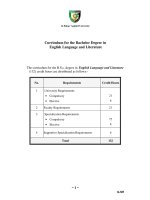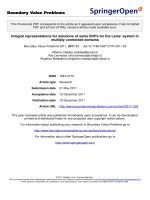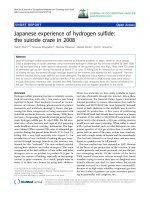Innovative methods for the Kannaviou CFRD in Cyprus pptx
Bạn đang xem bản rút gọn của tài liệu. Xem và tải ngay bản đầy đủ của tài liệu tại đây (978.43 KB, 10 trang )
Innovative methods for the Kannaviou CFRD
in Cyprus
Demos Antoniou
Water Development Department
Government of Cyprus
Nicosia
Cyprus
E-mail:
Introduction
Kannaviou Dam is a rockfill structure with a concrete face (CFRD) and is of great importance to the Cyprus water
management programme. It is the first Concrete Face Rockfill Dam built in Cyprus, so it is of great technical interest
and is the second highest with 75m height. The dam is founded on sound lava rock at the upstream part of it, near the
plinth area and on its sides and on alluvial deposits in the river valley floor downstream. A grout curtain 40m deep was
constructed along the plinth with the purpose to control seepages through the dam foundations.
Construction of the dam commenced on September 2000 and was completed on February 2006. The reservoir of
capacity 18 MCM was impounded on 28 October 2005 The diversion tunnel and draw off works are located on the right
abutment and consist of a 340m long tunnel, working as a diversion tunnel during construction, with two pipelines (700
and 1000mm diameter) and valves installed for water releases from the reservoir. Three intake points at different levels
are installed for operation at various reservoir levels.
The spillway is located in a large excavation through the terrace deposits and rock on the right abutment (west). The
spillway is free discharge structure with a 60 m long “ducks bill” ogee weir crest. The water discharges into a flat apron
area downstream the weir before it passes into an inclined chute, 86m long x 20m wide, which terminates in a 30
o
/ 45
o
deflector bucket energy dissipater. The spillway is capable of discharging the probable maximum flood which has a peak
discharge of 750m3/sec.
The innovative methods employed in the construction of the face slab, with the use of the self climbing top shutter,
equipped with a side concrete discharger and a rail system for fast transport along the crest, a custom made trolley for
reinforcement installation, produced excellent results and achieved a record of 3.5 m/hour of shutter average speed.
The unique method used for testing all of the copper waterstop brazed joints, represent an important milestone in the
concrete face dam construction.
This paper presents the methods used in constructing the dam, the quality control applied to the various materials
forming the embankment zones and the concrete face construction. A specific reference is made to the unique method
used for the first time in the testing of the copper waterstop brazing with the use of a vacuum box developed on site for
the purpose. A comprehensive instrumentation system was installed for monitoring both the dam’s embankment and the
face slab perimetric and vertical joints. Some results of the monitoring of the behaviour of the dam during construction
are also presented.
1. General Description
Kannaviou dam is located on the Ezousa River, about 40 km from the town of Paphos in the North West part of Cyprus.
The dam is owned by the Government of Cyprus and the engineering and design of the project was developed by KBR
(contracting as Howard Humphreys & Partners from the UK). The Contractor is AEGEK from Greece in a joint venture
with Iacovou Brothers and Cybarco from Cyprus.
The dam with maximum height of 75m, crest length of 600m and a volume of rockfill of 1.800.000 m³. The upstream
slope has a 1V: 1,4H inclination and the downstream slope is1V: 1,7H.The foundation of the dam is essentially on
pillow lavas of the Troodos formations. The upstream face is supported at the perimeter base with a reinforced concrete
plinth which is founded on sound rock of grade II to III and the rest of the embankment was founded on either rock or
alluvium. In the river bed, the layer of existing alluvium was removed downstream from the upstream concrete slab in a
strip equivalent to the base width of Zone 3B (see Figure 2). In the remaining area, the alluvium was incorporated in the
dam.
The reinforced concrete plinth is 0.5m thick and 5.0m to 11.2m wide. It is anchored to the foundation with 40mm
diameter high yield bars. The plinth forms a platform for the curtain grouting which is upstream of the embankment. The
line of curtain grouting under the plinth contains about 500 grouting holes of depth 40m. Upstream and downstream of
Vietnam National Commission On Large Dams
____________________________________________________________________
2
the curtain grouting there are the two lines of consolidation grouting, with about 1000 holes of depth of 10 meters. The
grouting holes were initially spaced at 3.0m centers. Grout takes were generally low, as expected from the preliminary
hole water test results. The grouting works were carried out using the GIN method. GIN numbers used are between 500
and 2000 and pressures varied between 10 and 30 bars depending on the location, depth and quality of the rock. A fully
automated uplift monitoring system had been devised to ensure that there was no vertical movement of the plinth during
grouting. The grout pumps were automatically switched off if the system detected movements greater than 1mm. This is
the first time this method has been used in Cyprus dam construction.
The upstream slab has a total area 42.000 m2 and thickness which varies from 0.30m at the crest to 0.45 m at the deepest
section as given by the formula d=0.3+0.002H. The concrete of the slab has a 28-day strength of 25 MPa, maximum
diameter of aggregate of 40 mm and average of 350 kg pozzolanic cement per cubic metre. Reinforcing of 0.4% was
adopted in each direction in the center of the slab. The slabs were concreted using a 15m wide slip form.
The sealing of the perimeter joint consists of:
- copper waterstop, installed in the base of the slab;
seal of asphalt mastic igas, at the top of the joint and;
a layer of silty non cohesive material, (Zone 1S), on the perimeter joint, protected on top with soft rock soil fill.
The sealing of all the vertical joints between panels were all treated as tension joints and consisted of a copper waterstop
installed in the base. A seal of asphalt mastic covered with a fabric rubber strip was used in addition to the copper
waterstop.
Figure 1 shows a general view of the project. The geometry of the dam and the zoning of the rockfill are shown in
Figure 2.
Figure 1. Plan showing the general arrangement of the project
2. Slab Construction
The upstream face of the embankment which has a total area of about 40000 square meters, is covered with a concrete
slab, which forms the water barrier stopping the water entering the embankment so creating the dam’s lake. This slab has
a thickness of 0.3m at the crest which increases by 2.0mm for every metre below the crest.
It is casted in panels of 15 m width and it is founded on the plinth which runs from the top of the left abutment through
the river bed to the top of the right abutment, totalling 650m. In total 40 panels were casted, 36 with the moving shutter
and four (two at either abutment) with top shuttering, due to their small length to accept the shutter.
Vietnam National Commission On Large Dams
____________________________________________________________________
3
The quality of the concrete forming both the plinth and the slab has to be of the best quality and durability, since these
two parts of the dam are very essential to the safety and proper functioning of the dam. Quite a number of trial mixes
were carried out in order to arrive at the desired mix which was finally used. The concrete used in face slab construction
has to be of such slump to flow down the chutes and be able to be compacted properly, but also to attain an initial set not
too late, to enable continuous movement of the shutter.
Concreting of the slab started on July 2004 and it was successfully completed on December 2004.
The sequence of the works associated with the face slab were as described below:
• First operation was the survey of the upstream face and the shotcrete protection applied to it. Due to movements
of the embankment during the construction stage and probable bulging, it was necessary to trim the face back to
its designed position, in order to enable the slab to be placed correctly and have the required thickness. This
required hand trimming and removal of the cut shotcrete.
• A second team followed and installed the mortal pads along the vertical joints. These were placed with a high
degree of accuracy, because their position dictated the final shape, the thickness of the slab and also its surface
specified tolerances. On these pads the cooper waterstop was placed along the full length of each bay.
• This operation was followed by the reinforcing mats placing team. These were transported down the face with
the use of a trolley travelling on two rail lines. The reinforcing mats were placed in the middle of the slab
thickness. The work started from the bottom of the bay and progressed up towards the top of the face.
• The slabs were castled consecutively, one after the other, so side shutters were placed only on one side of the
slabs. Concrete was casted against the previous slab at the other side. The moving shutter was moving on two
rail lines, one placed on the top of the shutter and at the other side on the previously casted bay.
The copper water stop came in six metres lengths and was placed from the bottom, with the first brazing on the water
stop running along the plinth’s perimetric joint. All the brazings which were carried out by experienced qualified
welders, were carefully visually inspected. A special test apparatus was developed on site, which enable every joint to be
tested under vacuum at 0.3 bars. This was proved to be a very effective way of testing the brazings of the cooper water
stop at every location and configuration of the joint. In total 750 tests were carried out, out of which 10 failures were
found which had to be cut out and repeated.
Concreting was continuous without stoppage so that a “cold” joint was always avoided along the bay width. The slump
of the concrete was carefully controlled to be between 7-9 cm so that the concrete could flow down the side chutes and
also to be retained under the top shutter and be compacted well before the shutter moved upwards. The shutter which
was the self climping type split in two halves, was moving up with the use of two hydraulic jacks on either side. The
speed of movement originally assumed to be in the range of 2-2.5 metres per hour maximum, was during construction
actually averaging 3.6 metres per hour, which is quite high for this type of work. At the bottom end of the shutter four
masons were giving the final levelling and shaping of the concrete surface by hand.
Attached to the moving shutter, there was a reel of hessian unfolding and covering the fresh concrete. About 8.0 m lower
a plastic perforated hose running along the width of the concrete was springing it with water, co that curing was
effectively starting just over two hours after casting.
All the vertical joints and the perimetric joint, which were treated as expansion, were filled with the i-gas material at the
top and protected with the hypalon cover. This was secured to the concrete with two GMS plates bolted to the concrete
on either side as required by the specified detail.
A very close monitoring of the internal pressures within the embankment, was done, to ensure that the drainage system
installed at the foundation, draining the lower part of the embankment was functioning properly. Not proper draining
could lead to build-up of internal pressures and cause damage to the slab.
After completion of the slab, the perimetric joint, below the level of 375m.el., was covered with a layer of fine silty
sand, whose purpose is to “collapse” and flow into the joint in case the water stop is damaged. Outside the sand a layer
of lava material of 3C was placed to protect it from erosion. The original design envisaged backfilling of the two vallies
up to the level of 375m.el. with general material 4A. This was later deleted and the area was flooded with water. This
enables re-visiting the plinth area for either additional grouting, if needed, or carrying out some work on the joint.
Vietnam National Commission On Large Dams
____________________________________________________________________
4
Photo.1 Upstream Face Slab Concreting
Photo 2. Self climbing slip form with side discharger
Vietnam National Commission On Large Dams
____________________________________________________________________
5
Photo 3. Reinforcement placing trolley
ZONING OF ROCKFILL
Rockfill for the embankment is selected from two designated Quarries A and B. Quarry A is a diabase quarry and
Quarry B, is a soft rock pillow lava quarry. These quarries are located within the reservoir area.
The embankment is divided into materials of zones 2A, 2B, 2C, 3A, 3B, 3C and 3D. Zone 2B, under the upstream slab,
has a width of 4.0m. This consists of screened alluvial extracted from the river bed, with maximum size 75 mm and fines
up to 8% (63 µm). It was compacted in 0.40m layers with 6 passes of 10 tonne vibratory roller. After the removal of the
excess material beyond the design line, the compaction of the slope was carried out with 4 passes of a vibrating plate.
After the compaction, the slope was protected with a layer of 50 mm shotcrete.
Zone 3B corresponds to the upstream section of the dam. The Zone 3B material consisted of sound rockfill taken from
Quarry A, spread and compacted in 0.8 m thick layers with 6 passes of 19 ton vibratory roller. During the unloading and
spreading, water was added at a ratio of 100 l/m³ of rockfill.
Zone 3A is a transition to Zone 3B. It has a width of 4.0m. This zone is of the same material as Zone 3B with sizes
greater than 200 mm removed, spread in 0.40m layers and compacted with 6 passes of 10-ton vibratory roller. The
placement of Zones 2B and 3A always followed that of Zone 3B, with removal of the segregated materials in the contact
between the two zones.
Zone 3C, corresponding to the downstream portion of the dam, was built mostly with pillow lava material produced
from the excavations and Quarry B. This rockfill was spread and compacted in 0.5 m layers with water addition up to 12
% and 6 passes of 19 tonne vibratory roller.
Zone 2A, with 2.0m of width and 3.0m of height, is located immediately downstream from the plinth. The material
placed along the perimetric joint, is produced from screened alluvial from the river bed below 20 mm and with fines up
to 10 %.
Zone 3D is the downstream slope protection layer 3.0 m wide and it comprises large river alluvial cobbles or crushed
diabase with maximum size up to 300 mm.
Vietnam National Commission On Large Dams
____________________________________________________________________
6
Error! Objects cannot be created from editing field codes.
Figure 2. Cross section of the Embankment showing the various zones of the fill.
3. Stages of Construction
The dam was built in two stages in order to meet the schedule, the requirements for plant utilization and use of materials.
The diversion of the river through the tunnel started before the winter 2001-2002 and following construction of the two
cofferdams in the main and side valleys. The main cofferdam included a permanent cut off wall, through the 15m deep
alluvium, which was achieved with jet grouting methods.
The construction of the dam began with the embankment on the downstream part, with direct placement of the material
from the excavations of the left abutment. These portions of the dam were built keeping a distance of 20m to 30m from
the final upstream slope of the dam, in order to avoid disruption of the construction of the plinth and the upstream
transitions at this construction stage. About 400.000 m³ were placed in the first construction stage.
After the construction of the plinth in the main and side valley river beds, construction of the second stage started. The
whole of the embankment was completed just before the end of June 2004.
4. Quality Control of construction
The geotechnical investigation of the foundations for the whole of the dam included about 700 m of core drilling and 40
permeability tests with the cores logged and tested for strength. The geological appreciation has been developed using
all the available information to assist in the final design of the plinth and also to evaluate the subsequent results of the
grouting works.
The investigations included rock mechanics tests carried out during the basic design, axial compression tests and
shearing tests of discontinuities.
The quality control of the rockfill and transition zones included in-situ density tests, permeability tests, gradings and
tests for the mechanical qualities of the materials. The average measured densities were : 2.33 Mg/m³ for Zone 2B
material, 2.3 Mg/m³ for the material in Zone 3A, 2.24Mg/m³ for Zone 3B material and 2.16 Mg/m³ for Zone 3C.
Strict control of the copper water stop brazing was carried out, with visual inspection, penetrability tests and vacuum
tests at 0.3 bars vacuum. For this purpose vacuum boxes were developed on site and have been used very successfully,
see Photo 4. The use of such method is applied for the first time in dam construction and it enables testing of every joint
to be carried out in-situ, with great accuracy and speed. Boxes were made to fit the various joint geometries. Vacuum
was applied with the use of a portable electric vacuum pump, up to 0.3 bars and kept for 20 minutes. If no drop of
pressure was observed the test was considered successful, otherwise the joint was cut out and re-brazed.
Vietnam National Commission On Large Dams
____________________________________________________________________
7
Photo. 4 Vacuum Box test on copper waterstop joints
5. Behaviour of the Dam
The behaviour of the dam during construction was monitored with instruments installed in three cross sectional
locations. Surface monuments were installed along two levels on the downstream slope of the embankment. The vertical
displacements in the embankment are measured with hydraulic settlement cells and the water levels in the dam’s
foundation with standpipe and vibrating wire piezometers. More vibrating wire joint meters and mechanical strain
gauges were installed later for monitoring the opening of the slab joints. ( perimetric and vertical).
Settlements measured in the upper section (elevation 395m) of the dam during the construction period, show that the
maximum recorded values at completion of the embankment were 160 mm in Zone 3B and 200 mm in Zone 3C. The
moduli of deformability of Zones 3B and 3C, determined from the measured settlement and the stresses corresponding
to the weight of the overlying layers, were 90 MPa and 50 MPa, respectively.
From the survey monuments installed on the downstream slope of the embankment the horizontal movements were of
the order of 10-20 mm in both directions and the settlements up to 50mm.
After impounding and following the application of the reservoir loading, the close monitoring of the joint movements,
showed that some joints started opening. The measured movements increased up to 7-8 mm, which is well within the
expected values. It is also shown that some movement is caused by the temperature seasonal variation effecting the
concrete’s shrinkage. All the movements measured to the end of June 2006 are shown in Fig 3.
Vietnam National Commission On Large Dams
____________________________________________________________________
8
KANNAVIOU DAM
PERIMETRIC JOINT METERS
-4
-2
0
2
4
6
8
10
Dec-04 Feb-05 May-05 Jul-05 Sep-05 Dec-05 Feb-06 May-06 Jul-06
MOVEMENT (mm)
+ve= opening
Figure 3 Perimetric Joint movements
6. Kannaviou Dam – Description of works
TABLE 1
Type
Concrete faced embankment with body of zoned Basal Group and pillow lava rockfill and filters and drains of
processed alluvium.
Hydrological data
Catchment area Approximately 56 km
2
Mean annual rainfall on area 770mm
Total annual inflow into reservoir 9.1 M.m
3
Reservoir capacity 18.0 M.m
3
Dimension
Crest elevation 419.1m AMSL
Original river bed at toe 363m AMSL
Base of alluvium 342m AMSL
Maximum height above river bed 56m
Volume of fill (all materials) 1,800,000m
3
River Diversion Works
Horseshoe shaped concrete lined tunnel and culvert
Diameter 3.3m
Tunnel length 340m
Culvert length 30m
Cofferdam crest level 376m AMSL
Capacity 43m
3
/s (50 year flood)
Inlet/Outlet Works
Concrete draw-off Tower connected to river diversion tunnel
Diameter 4.3m
Height 54m
Pipework Diameter: 600, 700 and 1000mm
Operational Drawoff Levels: 408, 395, 377.5 AMSL
Operational Drawoff: 1.0m
3
/s
Bottom Outlet Drawoff Level 376m AMSL
Bottom Outlet: 8m
3
/s
Spillway
Uncontrolled overflow concrete weir
Vietnam National Commission On Large Dams
____________________________________________________________________
9
Crest elevation: 414.0m AMSL
Crest length: 40m, into 10m wide chute
Routed discharge: 780m
3
/s
Foundation Treatment
Removal of full depth of alluvium, to found toe plinth on rock (requiring pumped wells and diaphragm wall under
upstream cofferdam)
Single row curtain, maximum depth 40m
Two rows blanket grouting depth 10m
Photo 2. General view of the completed Dam
The Author
Demos Antoniou graduated in Civil Engineering from London University (Queen Mary College) and worked since 1978 as an
Executive Engineer for the Water Development Department of the Government of Cyprus. He has been involved with the
construction of Asprokremmos, Evretou, Arminou and Kannaviou Dams. He has a vast experience with all aspects of dam
construction especially with Soil and Geotechnical Engineering such as:
- Rock and alluvial foundation grouting, diaphragm walls, rock anchoring, dam instrumentation and monitoring.
- Planning and quality control of all the works involved in the construction of dams.
He has worked in dam construction in countries outside Cyprus, such as Greece, England, Yugoslavia and Iran.
A lot of his work has been published in international Engineering magazines on Dam construction, instrumentation and embankment
behaviour. He has taken part in international symposiums and meetings and presented his work on Dam construction, including
CFRDs, in Cyprus and various other countries including Greece, Iran and China.
Vietnam National Commission On Large Dams
____________________________________________________________________
10
Demos Antoniou
Vietnam National Commission On Large Dams
____________________________________________________________________









